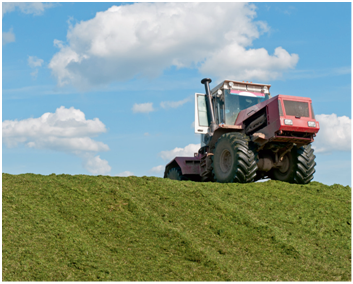Introduction
The application of live, viable lactic acid bacteria (LAB) to forages in the form of bacterial silage inoculants is paramount to driving fermentation toward a variety of desired endpoints. Some of the key factors that impact viability of bacteria for silage inoculants are: genus, species and strain, fermentation quality controls and stabilization methods, packaging, moisture and moisture control measures, temperature (especially heat) and storage conditions. Obviously, the two most important factors impacting shelf-life viability post-production and packaging are moisture and temperature.
Manufacturers of science-based, research-proven live, viable microbial products, like Chr. Hansen, rely on extensive technical diligence, process controls and patented technologies (e.g. U.S. patents 4,956,295 and 4,972,763) to ensure that bacteria used for a variety of applications, including silage inoculants, remain viable throughout their declared shelf-life or ‘Best Used By’ (BUB) date. One such example is the use of moisture scavenging products to minimize the detrimental impact of water activity on reducing shelf-life of bacterial silage inoculants. Although we can’t control storage temperature of our silage inoculants once they leave our production and storage facilities, we always strongly suggest that Chr. Hansen silage inoculants should ideally be stored in a cool, dry place away from direct sunlight. As dry, free-flowing powders, in their original containers, these inoculants will remain viable for several years and often have a label guarantee of 24 months; however, once exposed to the atmosphere or rehydrated their viability is highly variable.
For a variety of reasons, circumstances occur where distributors, dealers and end-users have Chr. Hansen silage inoculants that approach or pass their stated shelflife dates. Also, potentially adverse storage conditions or compromised packaging may lead to questions of viability. Thus, the questions arise, “Is this inoculant still viable? Does it still meet or exceed label guarantee?” The purpose of this technical bulletin is to share historical experiences related to Chr. Hansen silage inoculants that approached or had passed their shelf-life dates, as well as a few instances where storage or packaging was less than ideal.
Both BIOMAX® and SILOSOLVE® products were evaluated and included at least two (2) samples among seven (7) different products.
During the 4-year period from June 2016 to June 2020, a total of 29 Technical Service Requests (TSR) were performed to enumerate viable bacteria (total cell count) and water activity (aw). The 29 TSR included the following product mix: BIOMAX® (n=14), SILOSOLVE® (n=15) branded products, specifically: SILOSOLVE® AS (n=2), SILOSOLVE® MC (n=6) and SILOSOLVE® FC (n=7).
The vast majority of samples were evaluated after BUB date (69%) or for being exposed to a warm storage environment (>77°F; 21%) prior to BUB date.
Three primary reasons were provided for performing the 29 TSR. A ‘warm environment’ was interpreted to mean any storage conditions where temperatures exceeded 77°F for any length of time, including multiple days. Twenty samples were evaluated that were beyond BUB date by an average of 294 days (~9.8 months). Six samples were stored in warm environments (>77°F) and were evaluated before BUB date by an average of 380 days (~12.6 months). Two samples experienced ‘swelling’ or gas buildup in the canister causing distention of the foil seal, and were evaluated before BUB date an average of 265 days (~8.8 months). Finally, one sample was evaluated for viability 228 days before BUB for unstated reasons.
Water activity (aw), when evaluated, remained below 0.075 for all samples and averaged 0.050 for the 16 samples tested.
As stated previously, the two most significant environmental conditions detrimental to long-term shelf-life stability for microbial products are elevated ambient temperatures and water activity (moisture). Prudent evaluation of water activity upon sample submission facilitates the exclusion of this factor if bacterial counts are sub-optimal and water activity is minimal or below the acceptable threshold for the organism. Most bacteria, including lactic acid bacteria used in silage inoculants, require an aw >0.910 to grow or an aw <0.090 to prevent bacterial growth in a stabilized form. Optimal shelf-life stability is attained when water activity remains less than 0.150. All samples evaluated before their BUB date exceeded label guarantee, regardless of reason for evaluation. The nine samples evaluated before their BUB dates (~337 days post-manufacture) significantly exceeded total viable cell counts relative to label guarantee. Additionally, the six canisters evaluated before their BUB dates and stored in warm environments (~380 days post-manufacture) significantly exceeded total viable cell counts relative to label guarantee. The vast majority of samples (20 out of 23, ~87%) exceeded label guarantee when evaluated after their BUB date. Of the 23 samples evaluated after BUB, 20 exceeded label guarantee at an average of 294 days (~9.8 months) post-BUB. The three samples that failed to meet stated label guarantee at BUB, were an average of 655 days post-BUB (range 598-743; >21 months). This means that these three samples were >45 months post-production. No additional details were provided for these samples relative to temperature ranges, humidity or storage location.
Conclusion
In-house quality control and quality assurance measures can only ensure live, viable microbial products reach the field. Label directions indicate the ideal conditions for storage and use of products, but they cannot always be met. Product samples secured from the field can provide insights into product viability when handling, storage and use directions are not adhered to. Hopefully, these data shed some light on the robust measures that Chr. Hansen employs to provide the highest quality microbial products that conform to, and often exceed, their stated label guarantees.
Of note, Chr. Hansen silage inoculants, exposed to moderate periods of storage that are outside of optimal conditions, do not warrant analysis, as shelf-life and product performance are not affected.
Practically speaking, all silage inoculants should be stored in a cool, dry place away from direct sunlight.
Chr. Hansen branded silage inoculants, SILOSOLVE® and BIOMAX®, should be handled and stored according to label directions. Specifically, shelf life is 24 months at room temperature (<77°F).
Dr. Keith A. Bryan, Technical Services Specialist,
Dairy & Silage, Chr. Hansen















